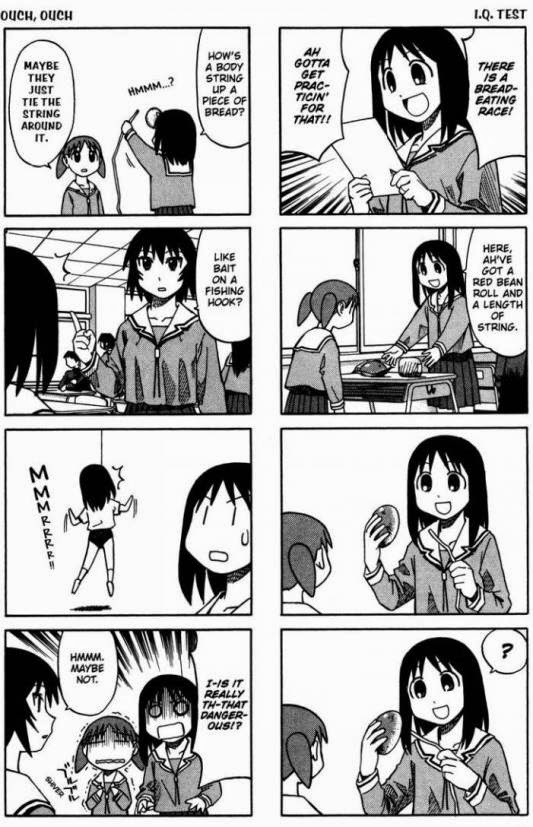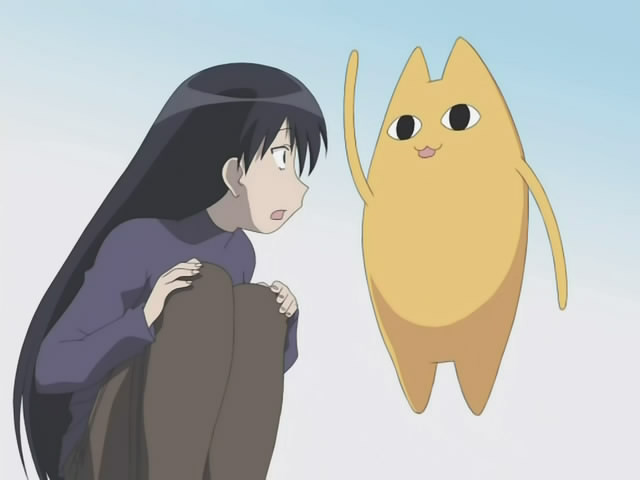
Revisiting Azumanga Daioh – by Lauren Bryant
Every once in a while, it’s fun to go rewatch a show from your childhood and see how it holds up today. And so it has been with me and Azumanga Daioh, a show I watched way back in middle school. It was the first or second of any kind of show that I ever watched all the way through (I was not a big TV-watcher), and so it still holds a special place in my heart. The animated series came out sixteen years ago and is based on a manga series that began in 1999 by Kiyohiko Azuma. The story centers around a group of highschool friends, the most notable of whom is Chiyo Mihama, a ten year old girl genius who has skipped five grades. Though you’d think she’d be very isolated because of this, she becomes friends with a number of her female classmates, and though her age difference is never quite forgotten, they all seem to get along well enough. The show is filled with silly gags and hijinks, and populated by some lovable characters (and some not-so-lovable ones). This lighthearted humor stuck with me over the years, and upon rewatching remains just as charming.

Of course, rewatching after all this time is bound to lead to a growth in perspective, and hence new observations. From a more formal perspective, the show has become much more fascinating to me visually. It’s not that Azumanga Daioh has stunningly complex visuals or any such thing; on the contrary, the animation is very minimalist, with lots of still shots and reused footage. At first, I wondered whether this was a sign of a small animation budget, or maybe even pure laziness. Yet that didn’t sit quite right, as it seemed more purposeful than anything. I felt it contributed to the absurdist humor at times, as well. Then I remembered the nature of the manga it was based off of: Azumanga Daioh is a strip manga, meaning that it’s more akin to comic strips then graphic novels. However, there are continuing storylines that span many strips, which means they can still be woven into episodes that make sense as a whole. With this in mind, I was able to look at the anime with a new lense. The details I was noticing before, such as prolonged still shots, seem to be a tribute to the original form, mimicking panel shots. I felt I was able to tell where one panel of the manga ended and another began, and even where individual strips ended. This made me respect the animation style in a way I never would have thought to before.

I’ve also become much more aware of some of the social issues in the series, both the good and the bad. One really interesting character is Kaori. Though she is not as central as some of the other characters, she is notable because she has a humongous crush on one of the main characters, Sakaki. Though I doubt I was unaware of Kaori’s sexuality when I watched it before, I hadn’t remembered how overtly gay the show makes her. She blushes profusely every time she sees Sakaki, dreams of her being a knight in shining armour come to rescue her, and plucks flower petals to see whether or not she’ll be in the same class as her the next year. I think the scene that tops the cake is when she gets to dance with Sakaki after a sports competition. Her face is one of pure bliss, a sea of yellow roses engulfs her, a church bell rises and rings behind her, and jets leaving rainbow trails in their wake fly through the sky. I’m not sure I’ve ever seen such obvious romantic imagery backing a lesbian couple in anime; there’s no room at all to misinterpret the queer overtones. Her love, though unrequited as far as I can tell, seems to me very wholesome and non-sexualized (which is important, because anime in particular has issues with fetishization). Sadly, no relationship ever blossoms from this, meaning that it’s not going the full mile for queer representation. However, to my untrained eye, this is a much better treatment than other series in the past have given to queer characters. Of course, I must say I am no expert on this subject, and I’m sure others can more adequately address the positives and negatives of this portrayal (if you want a more in-depth look at queer representation in animation, check out Art Ducko alumni Chloe Spencer’s article here: https://artduckomagazine.wordpress.com/2017/03/01/is-it-really-queerbaiting-a-brief-history-of-lgbtqia-censorship-in-mainstream-cartoons-by-chloe-spencer/). Nonetheless, I found this character to be quite interesting upon rewatching the series, and thus thought it worth mentioning her.
Unfortunately, the show has a big problem, which is embodied by the character Mr. Kimura. I’m sure he’s addressed by every single critic of this show, but that’s because he really needs to be. Even watching as a kid, I was aware that something was off, but only now do I realize just how bad it is. Mr. Kimura is a teacher at the highschool everyone goes to, and if my memory serves me correctly, one of his first lines of dialogue is him admitting he became a teacher so he could be around highschool girls. Sound problematic? Definitely. What makes it worse is that that’s the whole purpose of his character: though there are a couple scenes where he is not creeping on the main characters, they are a very small minority. He tries to watch the girls while they’re doing their swimming unit in P.E., calls them by endearing nicknames, and is constantly commenting on how he wishes the girls would dress. The only consolation, though small, comes from the fact that every single female character hates him. But though they yell at him and/or avoid him at all costs, I can’t help but feel like it’s not really enough. It’s good that they don’t approve of his behavior, but in the end, no one is doing anything to actually stop it. The action people take against him is minimal, and he is not fired despite the fact that he is being blatantly predatory. He is mostly played for laughs, and the result is that though it’s obvious people don’t like this kind of behavior, there aren’t any real consequences to it. Part of me wants to believe that this is all satiric, a biting criticism against issues of older men’s fetishization of highschool girls (which from my understanding is an actual problem in real-life Japan, and shows up in other media as well). Maybe it could be interpreted as a representation of the sad reality of harassment in Japan, where no one feels comfortable with what is happening, but they don’t feel emboldened to speak up because they don’t think the perpetrator will actually be punished. Maybe it shows how predators are allowed to just live normal lives and aren’t taken seriously: Mr. Kimura has a wife and daughter who love him, and the other boys at school seem to admire his honesty instead of taking seriously the worries of the female students. I want to think this, and it may really be what Azuma was going for, but the issue I run into is that it’s just not treated seriously enough. Mr. Kimura crosses so many lines, and yet he’s just portrayed as a character to laugh at. Since he’s the only named male character, this also sets a depressing precedent for what masculinity is in this series. There’s no positive depiction which we can look at instead as proof that this isn’t just what men are. So though Mr. Kimura can be considered parody, it does not make it any less unpleasant to watch his scenes, and I remain doubtful upon rewatching whether his character is actually accomplishing anything good.
Though I’ve just gone on a huge rant about Azumanga Daioh’s major flaws, I can’t say that I hate the show. The things I mentioned earlier in the article still stand out to me, and reflect what it’s like most of the time watching the show. In general, it is a very wholesome and hilarious show that I would recommend to people if you want something light-hearted to watch. But even if you love something, I think it’s important to acknowledge how it could be better. Though Mr. Kimura has relatively little screen time, glossing over the issues he represents would be a disservice. As much as I love the series, I am willing to take a look at the big picture, viewing both the good and the bad in tandem.


